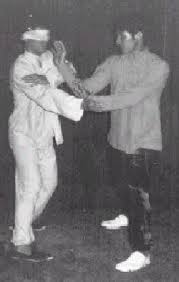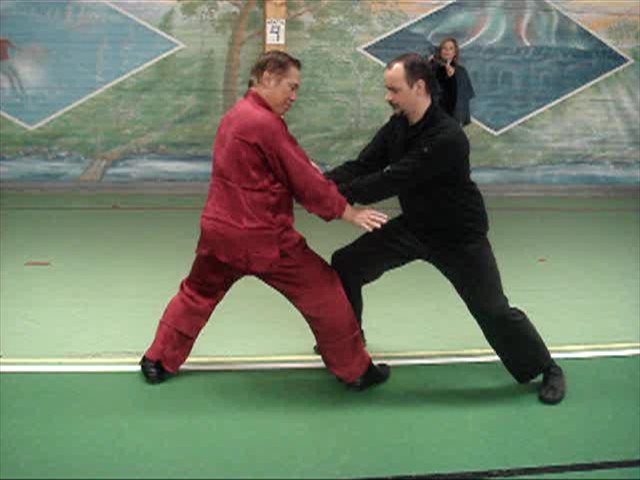HOW DOES ASKING BRIDGE ENRICH OUR DAILY LIFE

An old photo showing Grandmaster Wong and Sifu Khoi Koay Peng in Wing Choon sticking hands
Question
How does the skill of Asking Bridge and the increased sensitivity from training it enrich our daily lives?
Steffen
Answer
Although sensitivity is a main skill trained in Asking Bridge, there are also other beneficial skills developed from Asking Bridge.
I reckon that the term “Asking Bridge” is used here in its wide sense, which includes “Sticking Hands” in Wing Choon, “Pushing Hands” in Taijiquan, and “Kneading Hands” in Wuzuquan, besides “Asking Bridge” in its narrorer sense in Hoong Ka Kungfu. Indeed, in Hoong Ka Asking Bridge, the main aim is to train force rather than sensitivity.
To avoid confusion, I would use “Connecting Bridge” to refer to Asking Bridge in the wide sense, as in the coming course in Frankfurt in September 2014. “Connecting Bridge”, or “thap kiew” in Chinese (Cantonese) is a new term coined by me. As far as I know, it is also unprecedented. Not many kungfu practitioners, including masters, have an opportunity to learn all these four ingenuous methods of training sensitivity, force and other beneficial skills. Moreover, we do not learn these methods individually, we learn them as an integrated art with the advantage of the sum is more than its parts.
In the coming Asking Bridge course in Frankfurt, developing sensitivity is a main aim of the course. Of the four ingenuous training methods in Asking Bridge in its wide sense, or Connecting Bridge -- Asking Bridge in its narrow sense, Sticking Hands, Pushing Hands and Kneading Hands -- developing sensitivity is the main aim in two of them, namely Sticking Hands and Pushing Hands.
In descending order of importance, the value of developing sensitivity in these four arts is as follows:
Sticking Hands, Pushing Hands, Kneading Hands and Asking Bridge.
If we take developing force as the main criterion, the arrangement in descending order is as follows:
Asking Bridge, Kneading Hands, Pushing Hands and Sticking Hands.
Of course, the arrangement is relative. There is also some force development in Sticking Hands, and some sensitivity development in Asking Bridge.
My own estimation of the proportion between force development and sensitivity development of the four arts, based on my own experience, is as follows:
- Sticking Hands – 20:80
- Pushing Hands – 30:70
- Kneading Hands – 70:30
- Asking Bridge – 90:10
In other words, in Sticking Hands 20% of the training will develop force, and 80% will develop sensitivity. In Asking Bridge, 90% of the training will develop force, and 10% will develop sensitivity.
But with our benefit of breadth and depth, we can vary the orthodox proportion if we like, apart from choosing the right art for the purpose. We may, for example, use Sticking Hands to develop 60% of force and 40% of sensitivity, or use Asking Bridge to develop 50% of force and 50% of sensitivity.
Other students, even when they have the opportunity to learn their respective art, which itself is not frequent, would be unable to do so. A Hoong Ka student, for example, may develop a lot of force, but he may be unable to use Asking Bridge to develop sensitivity. Our ability to do so is an example of the sum is more than its parts.
Of course, as in any art, practitioners will have this result if they train correctly. If they don’t train correctly, not only they will not derive the result, they may have harmful effects. If they attain correct training haphazardly, they will take a much longer time to have result.
This is the first important benefit we can get from Asking Bridge, or any art. It is so important that it is worthwhile to repeat the lesson:
- To get the result the art is meant to give, we have to train correctly.
- If we do not train correctly, even when we use the right techniques, not only we do not get the desired result, we may have adverse effects.
- If our training is sometimes correct and sometimes not, it will take a longer time to achieve the desired result.
- If our training is correct and systematic, we shall achieve better result in shorter time.
This philosophy is so logical that many people may think it trite to mention it. Yet, shockingly, most people do not implement it.
More than 80% of those who practice arts of self-defence, not just kungfu, practice their arts wrongly. They cannot defend themselves. They regard being hit and kicked in free sparring as normal!
More significantly, we can apply this philosophy in our daily life. If you wish to get a better job or a good wife, for example, you must practice the art of getting a better job or a good wife correctly and systematically. If a person does so wrongly, like quarreling with his boss or messing with other people’s wives, he will have adverse effect.
A main reason why many people do not get the expected result from their training is because they do not realize the above philosophy, though they may think it trite when the philosophy is highlighted to them.
To go deeper, they do not understand the difference between techniques and skills. That is why they do not have the desired result even when their techniques are correct. That is also why most Taiji dancers do not have combat skills. Instead of using Pushing Hands to train sensitivity, force and other combat skills, they use it for public demonstration or their own recreation, which are beneficial too but are different from the desired result of practicing Pushing Hands.
For us, we go one very important step further, a step not many martial artists, including masters, can do. We apply the skills as well as the philosophy derived from our Connecting Bridge and other arts to enrich our daily life. We do not want to be very combat efficient but unsuccessful in our daily work and play, as even some past masters were.

Wuzuquan Kneading Hands
Such skills will enrich our daily lives. In a crowded place, if a burly person rushes at you, you can deftly move aside to let him pass, or if a lovely girl rushes at you, you may deftly hold her in your arms, instead of being knocked out in surprise. When you enter a room, you can sense who are friendly and who are hostile to you. When you talk to a person, like in a sale or in a friendly conversation, you can sense whether he agrees to what you say, regardless of what his oral response may be.
Developing force is also an important aim of Connecting Bridge, especially in Asking Bridge and Kneading Bridge. Having more force, coupled with better sensitivity, not just at the arms but in our whole being, certainly enriches our daily life.
Everything in life needs energy. When you have more force means you have more energy.
As another example of the benefit from the advantage of the sum being more than its parts, the force we develop when we use Asking Bridge for training, is versatile, whereas the force developed by typical Hoong Ka students, even when rightly trained, is consolidated. Consolidated force is useful when you want to push through to other people, like a manager telling his workers. If the manager wishes to present his proposal at a board meeting, flowing force will be more useful. Students who attend the Asking Bridge course in Frankfurt in September 2014 will be able to adjust his force for either or other role.
The Asking Bridge course enables students to respond correctly and spontaneously to combat situations in six harmonies. In other words, when an opponent attacks, they do not just respond, but do so correctly and spontaneously with harmonious hand techniques, footwork, body-movement as well as elegance, smooth chi flow and presence of mind.
Such knowledge and skills can be transferred to enrich our daily lives, directly or indirectly.
Without this knowledge, many people merely give a response when asked a question, often not answering the question.
For example, after a sumptuous dinner a host may ask, usually out of courtesy, “Did you enjoy the dinner?” Many people may answer, “The steak is delicious. I also like the wine.”
Strictly speaking, they did not answer the question. It was possible that the steak was delicious and they liked the wine, but still they did not enjoy the dinner. They should answer yes or no first, then talk about the steak and wine or other things.
If a person answers, “No, the food was tasteless”, he might be truthful but it is not a correct response for a host who has taken the time and effort to give him a sumptuous dinner.
If he says, “Yes, I enjoyed the dinner” while the host is talking to another person, the response is correct but he lacks the harmony of feet, or spacing and timing.
But is the guest telling a lie? No, he may not enjoy the food, but he can enjoy the thoughtfulness of the host. After all, it was a rhetoric question, asked for effect, not for fact.
Our students benefiting from the Asking Bridge course will do better. They will give a response correctly and spontaneously with six harmonies. Not only the response is correct and spontaneous, it creates the right effect (harmony of hands), spoken when the host is listening (harmony of feet), spoken while facing the host (harmony of body), spoken naturally (harmony of elegance), spoken audibly, clearly and in a relaxed manner (harmony of energy), with the students knowing what they are saying and also knowing that the audience understand what they are saying (harmony of mind).
The same principles apply to all other activities in our daily lives.

Connecting Bridge is more than the sum of its parts
Four Sequences of Asking Bridge
Glimpse of Asking Bridge, Saariselka 2011
Treasure House of Kungfu Sets
Treasure House of Combat Application
Those who wish to attend the 18-Lohan Fist course in Frankfurt, Germany on 26th, 29th, 30th September and 1st October 2014, please contact Secretary, Wahnam Germany or phone (069) 904-31954.
The questions and answers are reproduced from the thread 10 Questions on Asking Bridge in the Shaolin Wahnam Discussion Forum.
LINKS
